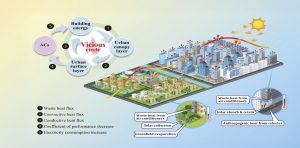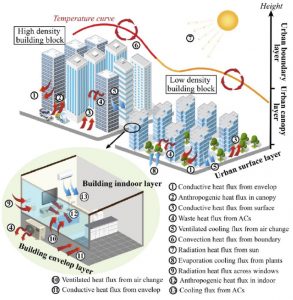As global warming intensifies and urbanisation accelerates, unsustainable urban growth and excessive energy use are heightening the risks of extreme climate events and energy insecurity in cities, creating a harmful cycle of environmental degradation and increasing energy demands. To break this cycle and foster the development of efficient, resilient, and sustainable smart cities, interdisciplinary collaboration is essential.
Challenges in Urban System Interconnections
Urban microclimates, energy systems, and building sectors are crucial for maintaining economic and social activities in cities. However, shortcomings in the design, operation, or management of any one of these areas can ripple through interconnected urban networks, causing widespread disruptions.
This problem can significantly increase a city’s energy consumption and carbon emissions. For example, dense clusters of urban buildings can intensify the urban heat island effect, driving up cooling demands. The waste heat released from air conditioning systems further raises temperatures. Moreover, worsening urban microclimates—characterised by changes in temperature, humidity, pollution, and precipitation—along with inefficient building designs and operations, place even greater strain on energy systems.
These dynamics also pose bigger challenges to urban health and sustainability. The lifecycles of urban energy systems and building sectors—from construction to operation, maintenance, and recycling—affect urban meteorology directly and indirectly. Poorly designed building clusters and emissions intensify phenomena such as urban heat islands, rain islands, wind islands, and pollution islands, leading to distinct and increasingly problematic microclimates in a city.
These harmful interactions further challenge urban resilience and reliability. The close interdependence between urban meteorological systems, energy networks, and the building sector means that risks or failures in one area can cascade into the others. In particular, in areas with dense building clusters and a reliance on centralised energy systems, extreme weather events like heatwaves, urban flooding, or typhoons can severely compromise energy security and may trigger widespread failures across the closely packed building clusters.
Cross-District Collaboration
Based on the distribution of building clusters, the zoning patterns of microclimates and energy systems in a city can vary distinctively. Variations in building functions, energy usage, and microclimate characteristics across different districts create opportunities for collaboration to address common challenges. Leveraging the complementary strengths of the energy supply types, grid structures, and load profiles from different districts can enhance the flexibility and resilience of the energy systems.
Emerging Technologies and Methods
Advancements in technologies such as the Internet of Things (IoT), big data, and artificial intelligence (AI) are revolutionising interdisciplinary collaboration. For example, digital twin systems, powered by sensor and communication technologies, enable smarter and more transparent management platforms for energy systems and building sectors. Meanwhile, advancements in materials science and new energy sources are helping to address challenges in cross-disciplinary efforts. For instance, using green phase-change materials and sustainable cooling technologies in building designs can help mitigate urban microclimate deterioration.
Effective Policy Guidance
Policy initiatives are key to promoting interdisciplinary collaboration among urban researchers. They play a vital role in resolving conflicts of interest, bridging knowledge gaps between disciplines, establishing unified information-sharing platforms, and building guidance and regulatory frameworks to support long-term sustainable development goals. Moreover, well-designed policies can help reduce social and economic inequalities as well as health risks that can arise from interdisciplinary initiatives.
Long-Term Planning
As global climate change accelerates, it is necessary to adopt more forward-thinking strategies in urban planning, construction, and management. The next generation of smart buildings will emphasise modularity, flexibility, and intelligence, aiming to build living environments that are not only efficient but also comfortable and sustainable. At the same time, smart energy systems will place more emphasis on decentralised regional autonomy, hybrid AC/DC networks, renewable energy integration, and demand-side efficiency, together paving the way for a low-carbon and reliable energy future.
About the author(s)
Yonghua Song is the rector of the University of Macau (UM), director of the State Key Laboratory of Internet of Things for Smart City, and a chair professor in electrical engineering at UM. He is also a Fellow of the Royal Academy of Engineering in the UK, a member of Academia Europaea and a Fellow of the Institute of Electrical and Electronics Engineers (IEEE). Rector Song obtained his PhD from the China Electric Power Research Institute in 1989. As an internationally renowned scholar, he has dedicated his career to research on power system analysis and control, making systematic and innovative contributions to the safe, efficient, and low-carbon operation of power systems.
Zhang Zhenwei is a doctoral student in electrical and computer engineering at the State Key Laboratory of Internet of Things for Smart City at UM. He earned his master’s degree in electrical engineering from Shandong University in 2022. His research focuses on the optimisation of urban integrated energy systems, with a focus on distributed resources, flexible loads, and microclimates.
Hui Hongxun is an assistant professor at the State Key Laboratory of Internet of Things for Smart City at UM. He obtained his PhD in electrical engineering from Zhejiang University in 2020. His research focuses on the optimal operation of energy systems, Internet of Things technologies for smart energy, power system economics and carbon markets, and interdisciplinary studies on energy and the environment.
Text & Photo: Yonghua Song, Zhang Zhenwei, Hui Hongxun
English Translation: Davis Ip
Source: UMagazine ISSUE 31
Academic Research is a contribution column. The views expressed are solely those of the author(s).
The vicious cycle between urban microclimates, energy systems, and building sectors

Factors such as heat emissions, pollution, and energy consumption interact with building characteristics and urban meteorological conditions, forming a complex web of interdepen

The interaction mechanism between urban microclimates and building power demands
